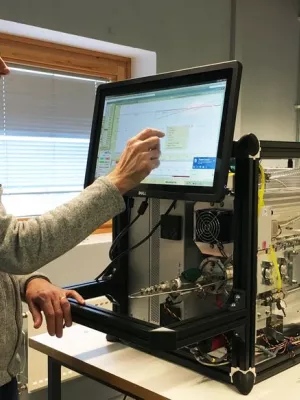
Erik Swietlicki
Professor

Modeling the role of highly oxidized multifunctional organic molecules for the growth of new particles over the boreal forest region
Författare
Summary, in English
In this study, the processes behind observed new particle formation (NPF) events and subsequent organic-dominated particle growth at the Pallas Atmosphere-Ecosystem Supersite in Northern Finland are explored with the one-dimensional column trajectory model ADCHEM. The modeled sub-micron particle mass is up to ∼75 % composed of SOA formed from highly oxidized multifunctional organic molecules (HOMs) with low or extremely low volatility. In the model the newly formed particles with an initial diameter of 1.5 nm reach a diameter of 7 nm about 2 h earlier than what is typically observed at the station. This is an indication that the model tends to overestimate the initial particle growth. In contrast, the modeled particle growth to CCN size ranges (> 50 nm in diameter) seems to be underestimated because the increase in the concentration of particles above 50 nm in diameter typically occurs several hours later compared to the observations. Due to the high fraction of HOMs in the modeled particles, the oxygen-to-carbon (O : C) atomic ratio of the SOA is nearly 1. This unusually high O : C and the discrepancy between the modeled and observed particle growth might be explained by the fact that the model does not consider any particle-phase reactions involving semi-volatile organic compounds with relatively low O : C. In the model simulations where condensation of low-volatility and extremely low-volatility HOMs explain most of the SOA formation, the phase state of the SOA (assumed either liquid or amorphous solid) has an insignificant impact on the evolution of the particle number size distributions. However, the modeled particle growth rates are sensitive to the method used to estimate the vapor pressures of the HOMs. Future studies should evaluate how heterogeneous reactions involving semi-volatility HOMs and other less-oxidized organic compounds can influence the SOA composition- and size-dependent particle growth.
Avdelning/ar
- Centrum för miljö- och klimatvetenskap (CEC)
- Kärnfysik
- Institutionen för naturgeografi och ekosystemvetenskap
- eSSENCE: The e-Science Collaboration
- MERGE: ModElling the Regional and Global Earth system
Publiceringsår
2017-07-24
Språk
Engelska
Sidor
8887-8901
Publikation/Tidskrift/Serie
Atmospheric Chemistry and Physics
Volym
17
Issue
14
Dokumenttyp
Artikel i tidskrift
Förlag
Copernicus GmbH
Ämne
- Meteorology and Atmospheric Sciences
Status
Published
ISBN/ISSN/Övrigt
- ISSN: 1680-7316